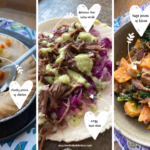Sophie Van Tiggelen:
Welcome everyone to this video on the topic of how to make the AIP diet more simple in the kitchen. My guest today is the world-famous Eileen Laird from the blog Phoenix Helix. Hi Eileen, how are you today?
Eileen Laird:
Hello, I’m very good. I’m excited to be talking with you and seeing your face.
Sophie Van Tiggelen:
Thank you so much, me too! So Eileen is a pioneer in the Autoimmune Protocol community. She has been living and healing diet and lifestyle since 2012 to manage her rheumatoid arthritis. What she has found works best for her is a combination of the AIP diet with some reintroductions, autoimmune medication, and a healthy mindset.
She’s also the author of a Simple Guide to the Paleo Autoimmune Protocol book and the host of the very popular Phoenix Helix podcast where I’ve had the honor of being a guest on two occasions.
Eileen, thank you so much for coming today and sharing your extensive experience with the Autoimmune Protocol.
You know that I’m a big proponent of meal prep and batch cooking. It’s helping me so much to stay on top of my diet. But the way each of us practice meal prep can be different depending on our time, our resources, and our energy level. So I’m interested to learn how you do it. Eileen, what does your meal prep routine look like?
Eileen Laird:
I have one of those magnetic calendars that you can put on your fridge and I sit down once a week and I do figure out my meals for the week and there’s room on that calendar for appointments and I know which days are busier and which days I have a little bit more time.
So when I do my meal planning, I don’t do one big batch cooking at the start of the week that I know some people do and really enjoy doing. What seems to work better for me is I cook a couple of nights a week, but I make enough for leftovers.
So on the busier days, I’ve got leftovers booked in. And then if something comes up and I’m having a tough day, you know, I shift, I do have some meals in the freezer usually that I can pull out for any emergency or I might shift it where say it was a recipe that was going to take a little time to do it might drop to, you know, beef patties and broccoli. Like just make it simple. So it’s modifiable.
But that meal plan piece is key for me. And the other thing I like about it being on the fridge is my husband sees it so he knows what’s up and I can put my defrost schedule on there too. So I’m not about to cook and realize that the salmon is still hard as a rock.
Sophie Van Tiggelen:
All right. So what I hear you saying is that you schedule with yourself like on your calendar. You place a time where you are cooking and when you have to defrost things and all the little tasks that you have to do. Do you plan also like I need to go shopping for these or I need to do this before that, you know, the dependencies?
Eileen Laird:
Yeah, that’s a good question. So we shop just once a week. Uh, well, we do two types of shopping, each one once a week.
So the farmer’s market is on Saturday and usually, we follow with grocery shopping on Sunday. So we know when that’s happening.
And I think we’ve talked about this before, you and I, we love to batch prep our vegetables. So when we come back from the farmer’s market, especially, cause that’s where we get a lot of our produce, we chop it everything up and I put them in these little Fridgesmart Tupperware containers. I don’t know if you’ve heard of those, but they’re kind of amazing.
They have this ridged bottom and then they have vents on the side and there’s a key for whether you keep both vents open, one open or both closed depending on the vegetable. And they seem to keep produce fresher by like two to three times longer than if I don’t put them in those containers.
So yeah, so we’ll spend a few hours getting all of that stuff done. And what’s nice is as we move into the workweek, we have salad makings for fast lunches, which is great, but even at dinner time, so while I’m the cook at dinner time, I don’t have to be chopping up the vegetables that are either going in the recipe or being cooked on the side. I just have to grab them, get a healthy fat, get them cooking up and I’m good to go. So, that has made a huge difference. Very time savings.
So I guess that’s my one batch. It’s not batch cook, but it’s batch prep.
Once every other week actually I do a big breakfast soup that I love to have in the morning and that is a really big batch, so it makes 12 servings and so that’s amazing. Then I just grab one from the freezer and I heat it up in the morning.
You’d think I’d get sick of it. I mean, I started that so long ago and when I first did it, it seemed like the weirdest thing to do, but it’s such a nourishing way to start the day. It feels comforting. Um, it naturally has bone broth in it. I feel like my body likes it. It’s satiating. It really helps me over way better than the type of breakfast I used to have before, which I’ll just say to people in case, you know, they put us on pedestals, I used to have a diet Coke and a Luna bar for my breakfast. Oh my gosh, I look back on that and I’m like, yeah, that was a good way to start my day. So it’s better now.
Sophie Van Tiggelen:
Do you make your own bone broth or do you buy it?
Eileen Laird:
I do make it and do it in the Instant Pot because it’s so easy. For the first couple of years, I did it on the stove and I wouldn’t say that was, that’s really hard. It’s just you have to kind of keep an eye on it because if you do it on the stove, it usually takes 24 hours and then we would have to add a little bit more water just because some evaporated out of the pot. It wasn’t like it was a big deal, but you had to kind of plan around it and you didn’t want it to finish in the middle of the night or whatever.
And the Instant Pot is just so easy. So pop it in, two and a half hours later, it’s done. I love that. And then I freeze it.
And um, Oh, and I wanted to do this. You had asked like what types of kitchen tools I used and I wanted to just show you the Mason jars that I freeze in because it took me forever to find a Mason jar you can freeze it. And so Mickey Trescott is one of the women behind Autoimmune Wellness. And she was always saying that if you had a wide mouth jar you could freeze it and it wouldn’t crack. And I had wide mouth jars and they cracked and I didn’t understand it and she finally explained to me.
So this is the jar that I have that’s a traditional wide mouth and it’s great for anything you put in the fridge.
I use it all the time for homemade kombucha, for broth. I’m using right away for sauces, for other things, a Mason jar salads. Like that’s great for all of those things. But you’ll notice even though it’s a wide mouth, there’s a tiny curve here and that’s all you need for a jar to crack in the freezer. Turns out it doesn’t crack every time, but it cracks enough to be annoying.

And then Mickey uses these. And so these are pint and a half instead of quart jars. So they’re a little smaller but they’re 100% straight. And so I put my broth into these and they’ve never cracked. And it’s such an easy way to fit a bunch of them in the freezer. And usually, you only need, like for the soups and things that I make, it usually calls for two to three cups anyway. And that fits in here. You don’t usually need four cups for a recipe. And if you do you can grab two jars. So I like that.

And then this other thing, these plastic reusable tops are so much easier to get on and off than the ones that are two pieces that come with the jars. So those are my tips.
Sophie Van Tiggelen:
Oh, that’s fantastic. I love that because it’s true. I’ve had the same happen to me. They just crack what is happening.
Eileen Laird:
And there are some great store-bought brands available. My favorites of the store-bought I think are Bonafide Provisions. I really like them and I think all of them are AIP- friendly. They have a ton of variety. And then Paleo On The Go. Super high quality, organic, gelatinous, delicious as well.
So if I do want to have, like life gets too busy and I just don’t feel like I can, it’s probably not a matter of not having the time. It’s just sometimes I think when you’re under a lot of stress you feel like you don’t have the energy. And then either Paleo On The Go or Bonafide are nice to just place an order and have some in the freezer and not have to worry about it that month.
Sophie Van Tiggelen:
So you mentioned your Instant Pot. Is there any other tool that you use often in the kitchen to make life easier for you? Like, I don’t know. I love the slow cooker too. And I also have huge baking sheets when I bake and batch cook vegetables in the oven.
Eileen Laird:
Sure. I use the slow cooker function on the Instant Pot, so I got rid of my slow cooker when I got the Instant Pot.
And one trick for people who are going to do that is: slow Normal on the Instant Pot is the same as slow cook LOW on a (conventional) slow cooker. And I made the mistake of thinking the slow cook LESS was what I should choose. And that’s, it just takes forever to cook things in. It’s more of a warming instead of a cooking. Just a little tip there. But I still like to slow cook some roasts in the Instant Pot rather than pressure cook cause they’re more tender.
Uh, what else? I love my spiralizer. So I have a recipe on my blog. That Salmon Primavera with Zucchini Noodles. It’s super quick. It cooks up in 30 minutes and it’s a one pot meal in the skillet. And the spiralizer is just fun and it never stops being fun. My husband actually loves spiralizing the vegetables, so he likes helping prep that meal. Um, so I like that one.
But otherwise just kind of basics. I have good quality skillets, pots, pans, baking sheets like you said.
I actually have some pretty fancy knives. Not that you need them to be fancy, but they’re high quality and we use them all the time.
And then a food processor is essential. For me, it was funny, before I went paleo, I hardly ever used it and I use it just all the time now because making cauliflower rice is really nice and just in general, I have recipes where I incorporate it into the recipe for quick chopping, sauce, creation, all that kind of stuff. I just think it’s really cool.
Sophie Van Tiggelen:
And it doesn’t have to be like a super fancy expensive food processor. Like the very simple ones, under $50, that you can find in any home good store will do the trick.
Eileen Laird:
Yeah, you can even probably find them in thrift shops because a lot of people buy them. A lot of people in the world don’t cook anymore, so when they’re clearing out their kitchen, they give away stuff that’s almost new. So if you’re really on a budget, you can check out there too.
Sophie Van Tiggelen:
My last question for you, Eileen, do you find that sometimes that fatigue, which is often associated with autoimmune disease, makes it harder to deal with all the cooking on AIP? And if yes, have you encountered this problem? What did you do? What’s your work around it?
Eileen Laird:
I think there are two types of things. Sometimes you’re just tired and you’re having a tired day and you just don’t feel like doing it. Other times you’re having an autoimmune flare and you simply cannot do it.
So I think having an emergency plan is helpful.
So I do think having some freezer meals done, whether you buy them or whether you make them and consider them your emergency stash, having those available for those days is really helpful
If you do not live alone, learning to ask for help is really helpful. And I find in this community we tend to be a bunch of helpers, people who have spent our lives helping people and aren’t as comfortable asking for help and even judge ourselves if we think we need help.
And I think one actual beautiful lesson of autoimmune disease is just embracing the humanity that giving and receiving goes both ways and you are worthy to receive.
So asking the people that you live with, whoever they may be, if they can help you in whatever capacity they can, I think is really important as well. So, so those are the things that I do.
Sophie Van Tiggelen:
Oh, that’s wonderful. I love both of your ideas. Thank you so very much, Eileen. We learned so much today. Thanks to your experience with the Autoimmune Protocol and I thank you for sharing all of your wisdom with us.
Eileen Laird:
You’re so flattering. I’m gonna be blushing here, but, um, I don’t know that I’m wise, but it was, it’s always fun to have these conversations and I was happy to do it. So thanks for asking.
Thank you so much!








Leave a Reply